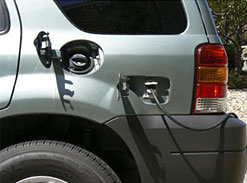
More on hybrids at Fordvehicles.com. or
Mercuryvehicles.com.
As they kick off the next phase of the project, the team was joined today at the utility company's Rosemead, Calif., facilities, by members of Ford's Sustainable Mobility team.
For the past week, engineers have been using an Escape Hybrid plug-in prototype, as well as a 2008 production Escape Hybrid, for comparison testing. Teams from the two companies ran the vehicles through a battery of tests to unify their methods and standards.
Both companies will then begin the longer-term engineering and technical work needed to determine the technology development and the usage patterns of customers, as well as explore possibilities for a sustainable business case that would help commercialize plug-in hybrids.
"We're looking for a solution that will be broader than just the technology. We understand the technical challenges to plug-ins, but we also need to understand how plug-ins really fit into the electric grid, and how we develop a business model that could actually make this technology accessible and affordable down the road," Nancy Gioia, Ford's director of Sustainable Mobility Technology, said Wednesday.
After initial testing in California, Ford will bring its plug-in prototype back to Dearborn to complete internal development tests. The first unit of the 20-unit demonstration plug in fleet will be shipped to the West Coast later this year.
The project joins Ford, the company that introduced the world's first hybrid SUV, with Southern California Edison, which has the nation's largest and most advanced electric vehicle fleet. The goal of the project is to make plug-in hybrid vehicles accessible to consumers, reduce petroleum-based greenhouse gas emissions and improve the effectiveness of the nation's energy grid.
Fueling at the plug rather than the pump would be less expensive for consumers, would reduce greenhouse gases and provide enhanced energy security while using domestic electricity during off-peak night hours.
Currently, plug-in hybrid electric vehicle technologies are not competitive; the advanced batteries that power them to meet the demands of the average consumer are prohibitively expensive and are yet to be proven for durability, reliability and safety.

